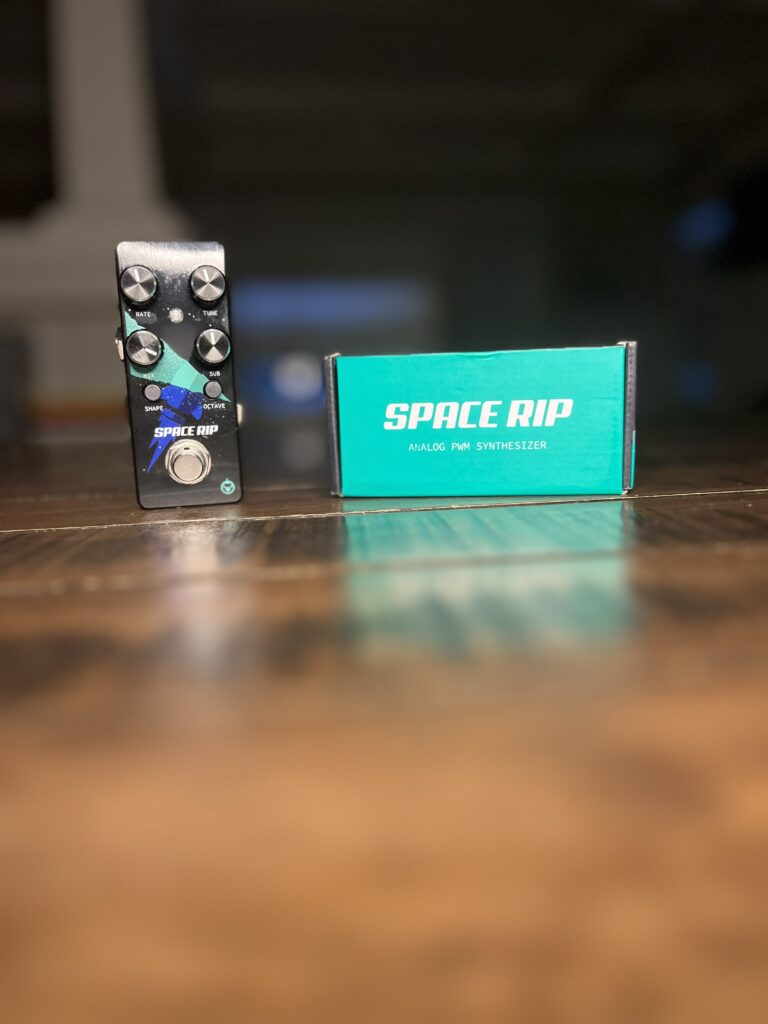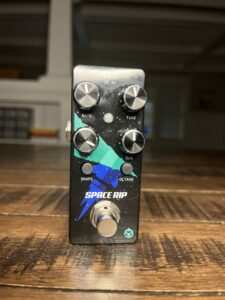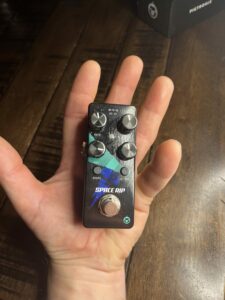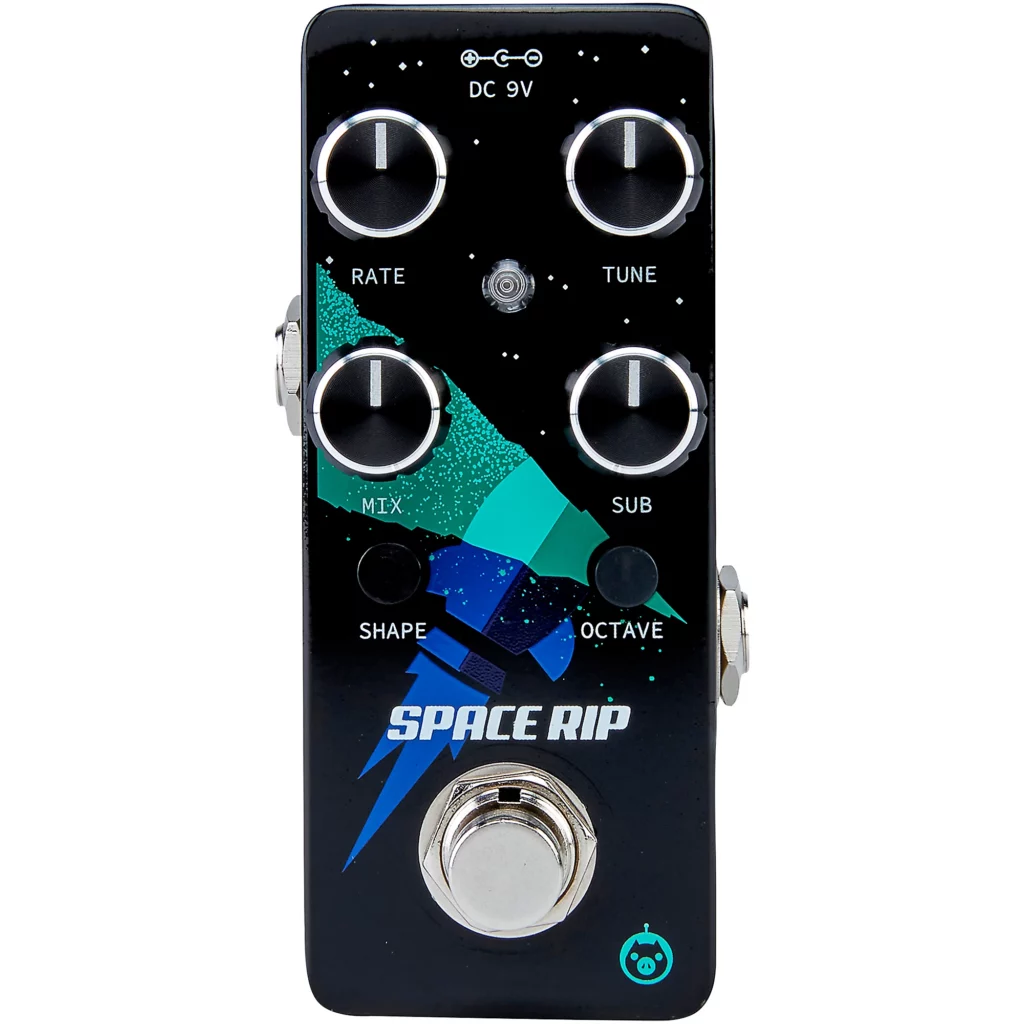The Space Rip by Pigtronix is a funky and well-built all-analog guitar pedal that sounds fantastic but won't appeal to the masses.
How the Space Rip can transform our guitar into a monophonic analog synth is mind-blowing. The square and sawtooth waves are instantly inspiring and fun ways to transform familiar riffs into something new and exciting.
Where the Space Rip falls short is that it's a niche product, and it will take a specific musician to incorporate it into their songwriting and have it take space on their pedalboard (even though it has a tiny footprint).
However, if you're looking for something that will take your guitar's tone into exciting new places, then the Space Rip may be the tool to fuel your unique creative vision.
I get it; you’re curious about the Pigtronix Space Rip and if it can actually rip through the fabrics of space itself (Pigtronix words, not mine :))
Well, I received a demo unit from Sweetwater to review. I have put this synth pedal through its paces and created the most comprehensive Pigtronix Space Rip review online (I’m a bit biased :)).
But in all fairness, the Space Rip will turn your guitar into an analog synth machine and change your perspective on what sounds you can coax out of your guitar.
There’s a lot of fun to be had experimenting with this particular pedal, but be sure to read this article before deciding to commit it to your collection. This pedal isn’t for the faint of heart!

Table of Contents
My First impressions of Using the Space Rip to Turn My Guitar Into a Synth
I was excited to receive the Pigtronix Space Rip from Sweetwater. I anxiously awaited my FedEx driver to drop off my package. When it did arrive, I quickly unboxed it and was impressed by how small and well-built it felt in my hand. It has the weight of an all-analog stompbox, and the knobs feel good to the touch.
I was highly intrigued by what this little guitar pedal would do to my guitar, and I had two burning questions before taking it for a spin:
- Could the Pigtronix Space Rip turn my guitar into a full-blown synthesizer?
- Could it replace my dependency and give me an analog alternative to my MIDI controller and soft synth sounds for recording?
Well, I plugged it in, plucked my first note, and was…confused. I first noticed how some notes I played got choked out by fuzzy chaos. I quickly learned that the Space Rip needs a healthy input signal to realize its musical potential fully. This will work better with electric guitars whose pickups have a hotter output, or if you use a boost before the Space Rip.
While there is something cool about how it crackles and breaks apart your sound (as the marketing suggests on the box…rip apart the fabric of spacetime in half), it isn’t always great when it happens in the middle of your riff.
From my experimentation, I found placing a compressor/sustain pedal before the Space Rip (I used the Pigtronix Philosopher’s Tone) helped to alleviate this problem of not putting enough force into your picking and having the note drop off.
It took some tweaking to reset my expectations and appreciate what the Space Rip offers.
This pedal does a fantastic job of transforming your guitar into a monophonic, fuzzy sawtooth, and square wave synth monster. Whether this is something you want in your guitar tone is something that the rest of this article will help you decide.
So what exactly is the Pigtronix Space Rip?
According to the Pigtronix packaging, the Space Rip is an “Analog guitar synthesizer featuring Pulse Width Modulation (PWM) sawtooth and square wave voices in multiple octaves with zero-latency pitch and dynamics tracking.”
While I don’t know exactly what kind of wizardry is going on under the hood of this guitar pedal, sonically speaking, it transforms your guitar into a funky and in-your-face beast.
The Pigtronix Space Rip combines modulation, fuzz, pitch shifting, and octaves to produce its sound. It can be melodic or downright alien sounding, depending on how you turn the knobs.
Who is the Space Rip For?
The Pigtronix Space Rip is not a solo effect if you consider using it for songwriting. It’s a tool that can work well in alternative, metal, and progressive music for head-turning solos and for transforming your guitar into a Moog-style bass synth.
I also see the Space Rip being an excellent synth pedal for cinematic composers. When you mess around with the rate and tune controls, you can produce other-worldly soundscapes that would fit into a sci-fi horror movie.
- A unique, innovative approach to guitar effects
- An inspirational pedal that opens you up to new ways of playing
- It totally transforms your guitar into an analog synth beast
- Create sounds from your guitar that will turn heads
- It doesn't work with chords, and you can't play sloppy into it
- It's a niche pedal that won't connect with every guitar player
How the Space Rip Works (With Original Audio Examples)

Because the Pigtronix Space Rip is a micro pedal, the controls are straightforward. However, the amount of different sounds you can conjure out of this box is vast, so I’ll give a breakdown of each knob and further opinions/thoughts on how to best dial in musical sounds (with sound samples, of course).
Each sound sample below was recorded with a Fender Vintera ’60s Jaguar HH Modified going into a Pigtronix Philosopher’s Tone, into the Space Rip, and a Supro Delta King 12” guitar amp. To record, I used a 47 FET replica into a Universal Audio Apollo Twin X. No processing was used on the signal.
The Rate Knob
The rate knob controls the speed of the pulse. When you crank the knob completely counter-clockwise, you will get the slightest wobble and movement. Crank it all the way clockwise, and you’ll get sounds that are like a UFO.
Take a listen…
The Tune Knob
The tune knob changes the voice of the synth. I recommend keeping it at noon if you want your guitar to sound in tune. If you shift the knob to 8, 10, 3, or 5 o’clock, I found that you can get some interesting harmony out of the Space Rip. Just make sure to check it against other instruments within your mix!
Take a listen…
The Shape Button
There are two tiny push buttons on the Pigtronix Space Rip. One is called Shape. This button toggles between sawtooth and square waves. You will hear the square wave when the button is pushed in; when it’s depressed, you’ll be in sawtooth mode.
The Sub Knob
The Sub control adds an octave underneath your main note. It will be turned off if you put this all the way counter-clockwise. However, I think you need to add a little bit to get the most out of these filtered synth sounds.
Take a listen…
The Octave Button
The other push button is the octave switch. This switch brings your original sound down an octave and adds another octave below that. This transforms a standard electric guitar into a bass. God help your speaker cone if you are playing a baritone guitar!
Take a listen…
The Mix Knob
This blends in your dry signal with the affected signal. I found that it’s best to max this thing out and let your guitar succumb to total synth madness.
Take a listen…
What I Love

I love the Pigtronix Space Rip for its unique and perspective-shifting approach to what an electric guitar can do. For my style and aesthetic, the sweet spot for the Space Rip is in creating thick synth bass sounds.
The squawking leads you can get from it are also incredibly fun and even come with that classic “zip” you get from an analog synth.
What I Don’t Love
While the Pigtronix Space Rip works precisely as advertised, I find the use case for this particular pedal so niche that it’s hard to think of it as a permanent staple in my signal chain.
I honestly feel like Pigtronix could have left off the Mix Knob and the Tune Knob. While the Tune Knob can add musical harmony to your sound, it’s difficult to dial in when performing with other instruments. Also, if you abuse this knob, you will alter your tuning to unusable in a traditional song context.
In my testing of the Pigtronix Space Rip, blending the original guitar tone with the affected sound isn’t ideal. Because of the amount of fuzz and sheer weirdness of the Space Rip sound, it’s messy. I recommend fully committing to the Space Rip and embracing it for all it is.
Where Should You Place the Space Rip on Your Pedalboard?
The Pigtronix Space Rip works great if you place it after dynamics like compression and before modulation. I discovered that because the Space Rip adds its own style of Fuzz to a tone, it didn’t play great with other drive pedals.
However, I’m confident some clean boost pedals could work going into the Space Rip. Still, from my experiments, I had the Pigtronix Gamma Drive. I enjoyed placing the Space Rip before the Gamma Drive, but this lends itself to experimentation.
Other Users Sound Examples
The Bottom Line
The Pigtronix Space Rip is an exciting pedal with a surprisingly broad range of sounds and sonic textures. If you want to add analog synth flavor and genuine synth bass to your guitar setup, this little box can do it all!
That said, this guitar pedal is very niche and catered to a specific guitar player. After reading this Pigtronix Space Rip review, I hope you are confident in knowing that this pedal is or isn’t for you.
Check it out on Sweetwater today!


